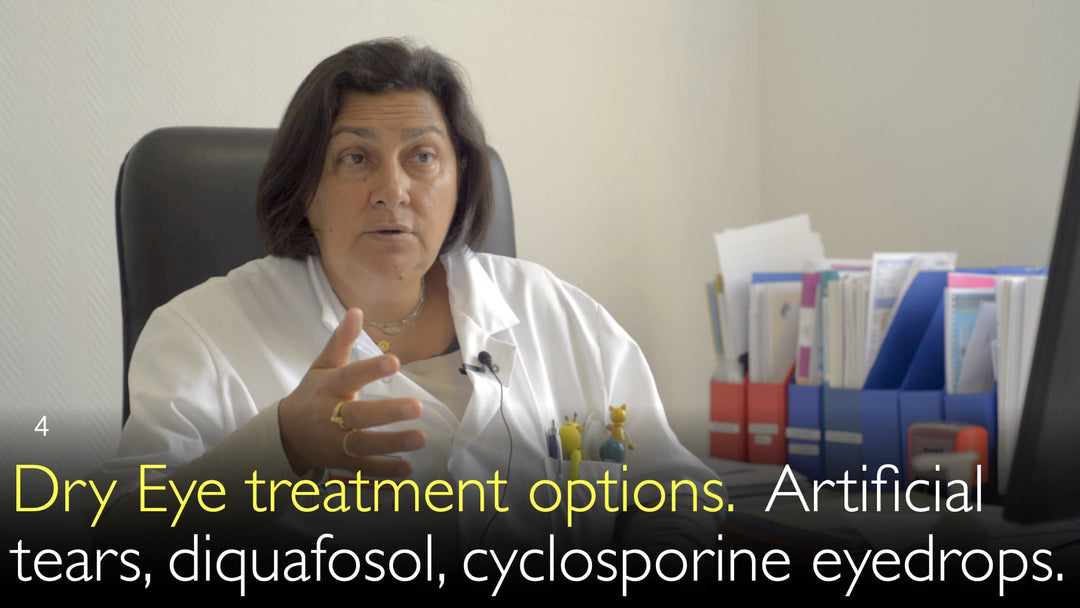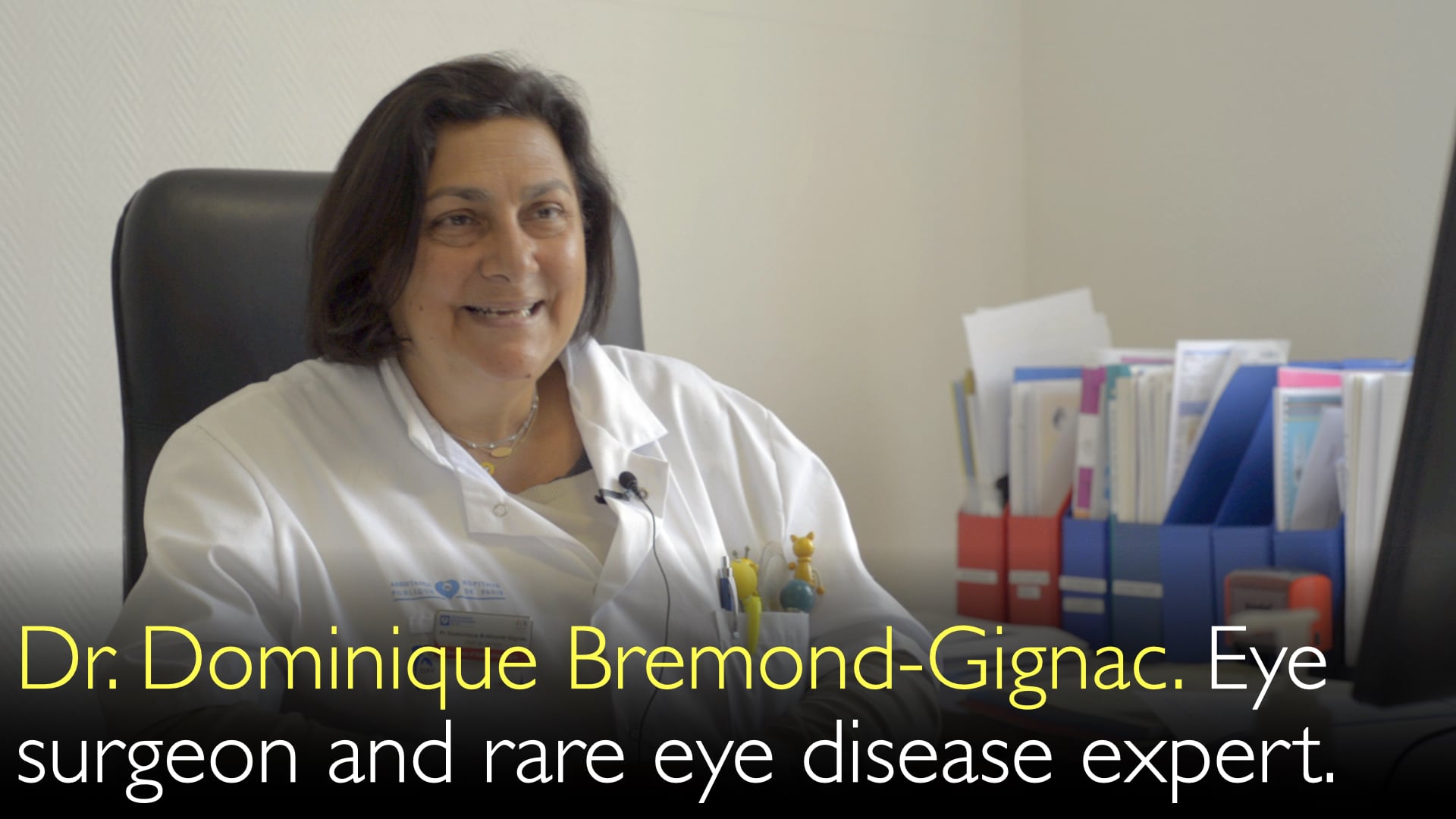Dominique Bremond-Gignac 박사(MD)는 안과 및 건성안 질환 분야의 선도적 전문가로, 만성 건성안 증후군이 단순히 인공눈물로 해결되지 않는 복잡한 염증성 질환이라 설명합니다. 그는 증상을 효과적으로 치료하고 안구 표면 건강을 보호하기 위한 혁신적인 항염증 사이클로스포린 점안액 및 기타 신규 치료법의 역할을 상세히 소개합니다.
진성 건성안 치료 옵션: 인공눈물부터 항염증 치료까지
목차 바로가기
- 건성안 증후군 이해하기
- 중증 건성안의 합병증
- 인공눈물: 복합 제형
- 염증: 건성안의 주요 구성 요소
- 사이클로스포린 점안액 치료
- 디쿼포솔 안약
- 건성안 치료의 미래 혁신
- 전체 대화 내용
건성안 증후군 이해하기
건성안 증후군은 매우 흔하면서도 복잡한 안구 표면 질환으로, 환자마다 증상의 경험이 크게 다릅니다. Dominique Bremond-Gignac 박사(의학박사)가 설명하듯, 증상의 심각도가 항상 임상적 징후와 일치하지는 않습니다. 일부 환자는 경미한 건성안으로도 상당한 기능 장애를 호소하는 반면, 다른 환자는 중증 건성안이 있어도 비교적 적은 불편함만 느낍니다. 이 질환은 각막을 포함한 안구 표면 전체에 영향을 미쳐 지속적인 증상을 유발하며, 환자들은 효과적인 완화를 찾아 수년간 여러 안과 전문의를 방문하기도 합니다.
중증 건성안의 합병증
중증 건성안은 시력과 안구 건강을 위협하는 심각한 합병증을 일으킬 수 있습니다. Dominique Bremond-Gignac 박사(의학박사)는 쇼그렌 증후군과 같은 진행성 건성안 상태가 환자와 의사 모두에게 큰 도전이 된다고 강조합니다. 건성안은 또한 이식편대숙주병, 백혈병, 눈물 생성과 질에 영향을 미치는 다른 전신 질환 등 비정형적인 임상 상황에서도 나타납니다. 이러한 복합적인 양상은 안구 표면 손상과 건성안 상태에 기여하는 기저 전신 염증 과정 모두를 다루는 특수화된 치료 접근법이 필요합니다.
인공눈물: 복합 제형
현대적 인공눈물은 자연 눈물막의 구성과 기능을 모방하도록 설계된 정교한 제형을 갖추고 있습니다. Dominique Bremond-Gignac 박사(의학박사)에 따르면, 오늘날의 인공눈물에는 히알루론산과 안구 표면에 향상된 윤활과 보호를 제공하는 다른 성분들을 포함한 복합 약제 연합체가 들어 있습니다. 이러한 고급 제형은 건성안 환자들에게 기초 치료제 역할을 하며, 일시적인 증상 완화를 제공하고 각막 무결성을 유지하는 데 도움을 줍니다. 복합 인공눈물 용액의 개발은 기본 건성안 치료에서 상당한 진전을 의미하며, 다양한 건조증 심각도를 가진 환자들에게 여러 옵션을 제공합니다.
염증: 건성안의 주요 구성 요소
건성안 질환에 대한 이해는 염증이 병태생리학에서 중심 역할을 한다는 인식과 함께 크게 진전되었습니다. Dominique Bremond-Gignac 박사(의학박사)는 건성안이 단순히 건조함이 아니라 안구 표면의 상당한 염증을 수반한다고 강조합니다. 이 염증 요소는 표면 자극이 더 많은 염증을 유발하는 악순환을 만들어내어, 결국 눈물 생성샘과 안구 표면 세포에 추가 손상을 초래합니다. 이러한 기저 염증을 해결하는 것은 현대 건성안 치료 전략의 중요한 초점이 되었으며, 단순한 윤활을 넘어 질병 과정의 근본 원인을 표적으로 삼고 있습니다.
사이클로스포린 점안액 치료
사이클로스포린 점안액은 질병의 염증 요소를 특별히 표적으로 삼아 건성안 치료에서 상당한 진전을 이루었습니다. Dominique Bremond-Gignac 박사(의학박사)는 이 약물이 봄철 결막염 치료에 사용되는 것과는 다른 낮은 농도 제형을 사용한다고 설명합니다. 사이클로스포린은 면역조절제로 작용하여 안구 표면의 염증을 줄이고 시간이 지남에 따라 정상적인 눈물 생성을 회복하는 데 잠재적으로 도움을 줍니다. 건성안 질환의 가변적인 특성으로 인해 효능을 입증하는 임상 연구가 어려울 수 있지만, 많은 환자들이 사이클로스포린 치료로 증상에서 상당한 완화를 경험하여 만성 염증성 건성안이 있는 환자들에게 중요한 옵션이 되고 있습니다.
디쿼포솔 안약
디쿼포솔 3% 안약(Diquas로 판매)은 건성안 치료에 대한 또 다른 혁신적인 접근법을 나타내지만, 그 이용 가능성은 지역에 따라 다릅니다. Dominique Bremond-Gignac 박사(의학박사)가 언급했듯이, 이 약물은 현재 유럽에서는 이용할 수 없지만 건성안 치료 개발에서 중요한 영역을 대표합니다. 디쿼포솔은 항염증제와는 다른 메커니즘으로 작용하여, 안구 표면 세포에서 물과 뮤신 분비를 모두 자극하는 P2Y2 수용체 작용제로 기능합니다. 이 이중 작용은 눈물막의 양과 질을 모두 개선하여 건성안 질환의 여러 요소를 해결하는 데 도움을 줍니다.
건성안 치료의 미래 혁신
건성안 치료 분야는 새로운 치료 옵션의 지속적인 연구 및 개발과 함께 계속 진화하고 있습니다. 제약 회사들은 건성안 치료에서 혁신을 위해 적극적으로 노력하고 있지만, Dominique Bremond-Gignac 박사(의학박사)는 질병의 복잡하고 가변적인 특성으로 인해 임상 연구를 수행하는 데 어려움이 있음을 인정합니다. 미래 방향에는 건성안의 여러 측면을 동시에 다루는 병용 요법, 새로운 항염증제, 그리고 안구 표면 재생을 촉진하는 치료법이 포함됩니다. Anton Titov 박사(의학박사)와의 논의에서 Bremond-Gignac 박사는 만성 건성안이 눈물을 보충하는 것뿐만 아니라 기저 염증을 해결해야 한다는 점을 환자가 이해하는 것의 중요성을 강조하며, 고급 치료 옵션에 대한 지속적인 교육의 필요성을 부각했습니다.
전체 대화 내용
Anton Titov 박사(의학박사): "건성안"은 흔한 안구 문제입니다. 환자들은 보통 여러 해 동안 건성안 증상을 경험합니다. 그들은 많은 안과 의사를 방문하지만 종종 치료 결과에 만족하지 못합니다. 그런 다음 그들은 또 다른 안과 의사를 찾아가 더 나은 결과를 기대합니다.
"건성안"의 원인은 무엇인가요? "건성안"의 합병증은 무엇인가요? "건성안"의 최선의 치료법은 무엇인가요? 건성안 치료 분야에 어떤 혁신이 있나요?
Dominique Bremond-Gignac 박사(의학박사): 건성안 증후군은 매우 흥미로운 질병입니다. 왜냐하면 흔한 질병이기 때문입니다. 건성안 질환을 특징짓는 것은 일부 환자는 매우 경미한 형태의 건성안으로도 기능 장애를 겪는다는 점입니다. 다른 일부 환자는 매우 중증 형태의 건성안이 있어도 그다지 기능 장애를 겪지 않습니다.
그러나 문제는 건성안이 안구 표면에 영향을 미치기 때문입니다. 그것은 각막에 영향을 미칩니다. 그래서 쇼그렌 증후군과 같은 매우 중증 형태의 건성안의 합병증이 발생합니다.
셋째, 우리는 건성안을 위한 정말 좋은 치료법이 필요합니다. 소아에서도 건성안 증후군이 존재합니다. 그리고 물론, 비정형적인 발현도 있습니다.
이식편대숙주병에서도 건성안 증후군이 있습니다. 예를 들어, 백혈병, 장기 이식에서 건성안이 존재합니다. 건성안은 매우 비정형적인 모든 상황에서 발생합니다.
그러나 건성안은 또한 정말 효과적인 치료가 필요합니다. 그래서 우리는 매일 건성안 치료에서 혁신을 이루려고 노력합니다. 제약 회사들이 그 분야에 일하고 있습니다.
매우 흔한 인공눈물이 있습니다. 오늘날 인공눈물은 매우 복합적인 약제 연합체이며, 매우 흥미로운 연합체입니다. 우리에게는 히알루론산이 있습니다.
인공눈물의 모든 이러한 성분들은 매우 좋습니다. 그래서 우리는 건성안의 기초 치료를 위한 인공눈물을 가지고 있습니다. 우리는 오늘날 건성안 환자들에게 인공눈물을 사용하기 위한 많은 옵션을 가지고 있습니다.
또한, 우리는 안구 표면을 수리하기 위한 건성안 치료법을 가지려고 노력합니다. 그러나 우리는 또한 건성안 치료의 새로운 개념으로 나아갑니다.
건성안 질환이 건조함만이 아니라 염증도라는 것을 설명하는 의학 회의와 책이 있습니다. 그래서 건성안이 단순히 건조함만이 아니라는 것을 이해하는 것이 매우 중요합니다.
그것은 또한 안구 표면의 염증입니다. 그래서, 우리는 이 염증과 싸우기 위한 일부 점안액을 찾아야 합니다. 이것은 매우 중요합니다.
그것이 왜 사이클로스포린 점안액이 낮은 농도로 또한 사용되는 이유입니다, 이는 봄철 결막염 치료와는 다른 제형입니다. 건성안을 위한 또 다른 치료 개념도 있습니다. 그것은 디쿼포솔 3% 안약(Diquas)입니다.
그러나 유럽에서는 그것을 가지고 있지 않습니다. 건성안 치료를 위한 많은 개발 영역이 있습니다. 그것은 그렇게 쉽지 않습니다.
그러나 분명히 일부 새로운 치료 가능성이 있습니다. 건성안 임상 연구를 수행하는 것은 항상 어렵습니다. 왜냐하면 건성안 질환의 표현을 이해하는 것이 그렇게 쉽지 않기 때문입니다.
건성안은 매우 복잡합니다. 왜냐하면 그것은 환자마다 다르기 때문입니다. 그래서 왜 우리는 새로운 점안액에 대한 많은 임상 연구를 가지고 있지만, 치료 성공을 입증하는 것은 어렵습니다.
그것이 문제였습니다. 건성안을 위한 사이클로스포린 점안액 연구가, 저는 희망합니다, 그것이 정말 유용하다는 것을 입증할 것입니다. 왜냐하면 우리는 건성안 증후군을 가진 환자들이 있기 때문입니다.
우리는 건성안 환자들이 사이클로스포린 점안액으로 그들의 증후군에서 완화된다는 것을 알고 있습니다. 그래서 저는 희망합니다 그것이 더 효과적인 치료 방법이 될 것입니다.
Anton Titov 박사(의학박사): 그래서 이것은 중요한 요점입니다. 여러 해 동안 지속되는 건성안 증상을 가진 환자들은 그것이 단순히 건조함이 아니라 원인 수준에서 치료되어야 할 일부 기저 염증이 있다는 것을 인지해야 합니다.
그리고 따라서, 예를 들어, 잠재적으로 사이클로스포린 치료 사용에 대해 안과 의사와 이야기하는 것이 유용합니다. 물론, 그것은 환자의 상황에 따라 다르지만, 그것 또한 도움이 될 수 있고 최신 가용 인공눈물을 사용하는 것.
Dominique Bremond-Gignac 박사(의학박사): 정확합니다. 그것은 정확히 건성안 증후군과 염증에 대한 매우 좋은 요약입니다.
Anton Titov 박사(의학박사): 감사합니다!





